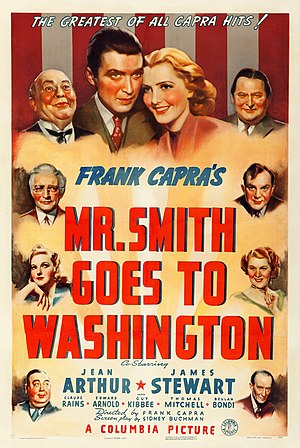Mr. Smith Goes to Washington
Jump to navigation
Jump to search
| Mr. Smith Goes to Washington | ||||||||||||||||||||||||
|---|---|---|---|---|---|---|---|---|---|---|---|---|---|---|---|---|---|---|---|---|---|---|---|---|
This film has been preserved in the National Film Registry in 1989.
| ||||||||||||||||||||||||
 | ||||||||||||||||||||||||
|
Mr. Smith Goes to Washington is a 1939 American political comedy-drama film directed by Frank Capra, starring Jean Arthur and James Stewart, and featuring Claude Rains and Edward Arnold. The film is about a newly appointed United States Senator who fights against a corrupt political system, and was written by Sidney Buchman, based on Lewis R. Foster's unpublished story "The Gentleman from Montana". The film was controversial when it was first released, but successful at the box office, and it made Stewart a major star.
Why It Rocks
- During the 1930s, Frank Capra was one of the most influential and recognisable directors in the industry, releasing a slew of popular movies such as It Happened One Night, and a number of other films under Columbia. Mr. Smith is his last film for Columbia, and he'd rework the themes and characters from his most successful earlier films, but now they're on a national scale.
- Over the years, Capra's heroes refined from brash, abrasive reporters to sort of a guileless innocent surrounded by treachery, with the brassiness shifted over to the heroine. Jefferson Smith and Clarissa Saunders would serve as the "guileless innocent" and "brassy heroine" retrospectively.
- Jefferson Smith is an excellent protagonist and an optimistic hero who wants to create a Boys Ranger Camp for the boy scouts. His journey is much more endearing because we believe that he is a common man thrust into an uncommon situation, and as a result, he stands out as the only Senate member who isn't corrupt. He's simply an ordinary, honest guy taking on Washington politicians, an action almost any American would rally behind.
- (Clarissa) Saunders is Smith's secretary and assistant who's just as attracted with Smith's simplicity as the audience is and helps him in his struggle initially. She also has a sarcastic wit and street-level charm to her and is a strong independent female character who guides the hero on his path of victory.
- Like some of Capra's other films, the leads are surrounded by veteran character actors who provide the exposition explaining plot points and provide cynical wit, preventing the film from becoming too sentimental.
- Most of the principal actors casted were people Capra had worked with before. Harry Carey got an important part as the president of the senate
- Thanks to this film, 1939 was the breakthrough year in James Stewart’s career after half a decade of mostly supporting roles and second leads.
- Jean Arthur was a major star with a lovely flair for comic timing. She exhibits fine dramatic range as she transforms from jaded cynic to passionate believer, a vital character shift because it reinvigorates Stewart’s own character to keep pushing forward.
- The plot of the film is fairly simple, but it's still as timeless and relevant as ever due to the simple dilemma that the title character faces whether to honestly do his Job and be crucified for it or to give in to the corruption so that he could have a long career as a politician, it also explores how simplicity and morality are sacrificed when it comes to bureaucracy as the wide-eyed Mr. Smith holds on to his ideals even though the going gets tough -- Very tough.
- Capra incorporated several technical innovations into the film. He filmed with multiple cameras, resurrecting a technique from the early sound era, meaning he could run through entire scenes instead of repeating portions for close-up insert shots. When close-ups were necessary, he used projecting equipment to play back dialogue, rather than having a continuity person feed lines to actors.
- Capra was a master of comic timing, having developed his skills years earlier making silent comedies for producer Hal Roach. His instincts went beyond just physical choreography of gags; he was an astute visual storyteller who understood how to use cinema to guide an audience though emotional buildups, comic or otherwise. One example is the editing of a scene as simple as Guy Kibbee being comically harassed by his kids at the dinner table. A bigger one is the filibuster sequence, which Capra breaks into many small segments—some of them far removed from the Senate chamber itself— without losing an ounce of the rising intensity overall. There's also bits of comedy and heartfelt romance in what's mostly a serious, dramatic sequence.
Bad Qualities
- The film attracted some controversy for painting senators as corrupt and the Senate susceptible to demagogic manipulation. This is despit the fact that the film never identifies Jefferson Smith's home state or whether he was a Democrat or a Republican (although his seat was on the Democrats' side of the aisle)